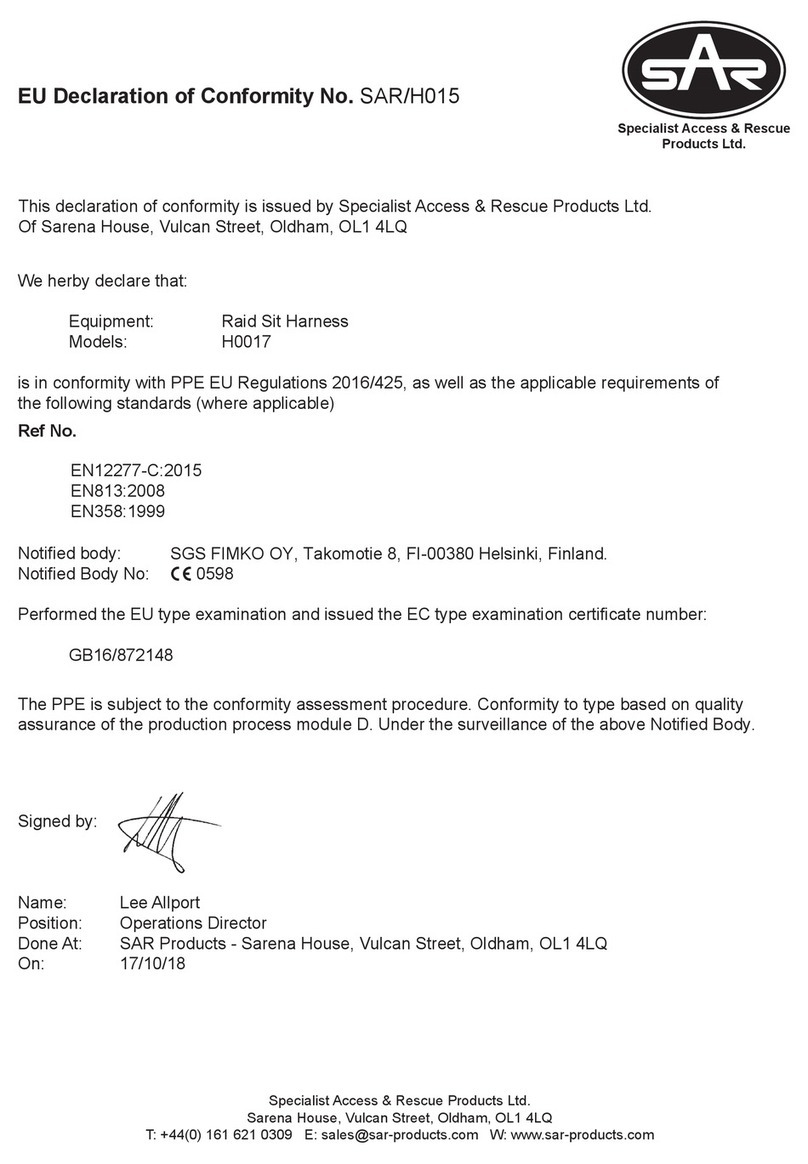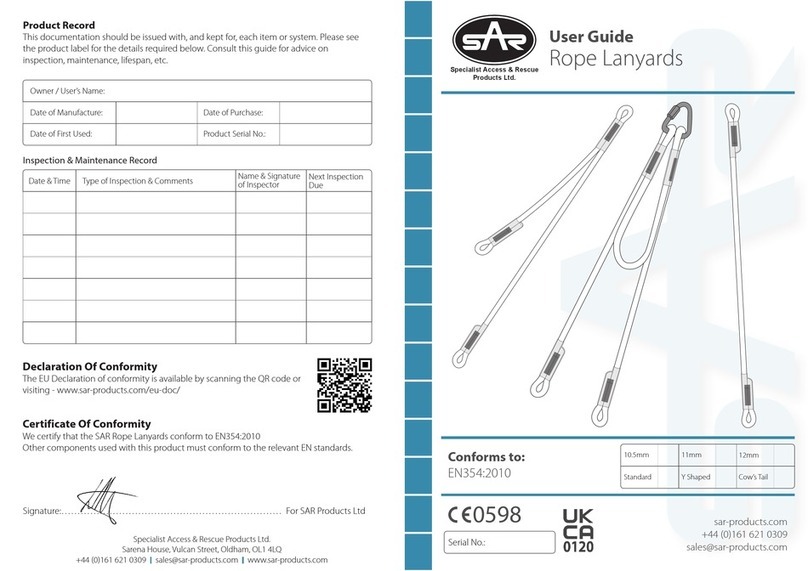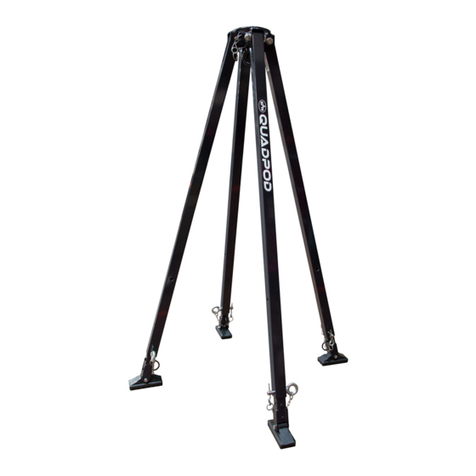
Specifications
Materials & Coatings:
Legs: Aluminium powder coated.
Head: Stainless steel powder coated.
Bolts & Pins: Stn. steel, Mild steel, Nickel plated
Straps: Polyester webbing.
Weight
Quadpod only: 12.8Kg
Leg Securing Straps: 1Kg
Storage Bag: 0.5Kg
Meanings Of Markings
• The name, trademark or any other means of identification provided
by the manufacturer or supplier.
• The batch or serial number
• Date of Manufacture (DoM)
• UKCA &/or CE mark with approved &/or notified body number
• The British &/ or EN standard(s) to which the item conforms
• Product description and/or reference
• Evaluation of capacity in Kg
Notified body
SGS FIMKO OY, Takomotie 8, FI-00380 Helsinki, Finland.
Notified Body No: 0598
Approved Body UKCA
SGS United Kingdom Limited
Rossmore Business Park, Ellesmere Port, Cheshire, CH65 3EN
Approved Body No: 0120
The Quadpod can be used in other positions as shown below.
The positions show below do not fall under the test requirements of the
above standards and careful consideration and calculations of loads must
be taken into account by the users before carrying out any tasks.
1. Offset pyramid
2. Half pyramid
3. Overhanging
Settings 1, 2, & 3 do not fall under the test requirements for EN795 and
CEN/TS 16415. Option 2 & 3 positions must be anchored and the anchors
strong enough to conform to the standard 15kN.
1. The offset pyramid is best for tensioned cable lines using the central
connecting eye for your pulley. The reason for this is the force down
should be central to the Quadpod when you dissect the angle.
Another pulley can be fitted under the cable pulley or pulleys for the
hauling.
2. When using the half pyramid or overhang setting for cliff or edge
rescue, you should use the front outer ring connecting point. By
fitting a Dee Mallion to the ring, then a karabiner for the pulley or a
Delta Mallion for twin pulleys. The angle of the load will be central to
the Quadpod and there should be no need to fasten down to secure
the legs. In these positions you MUST use a back securing rope from
a firm anchor to the top back outer ring prior to load being put onto
the system.
When using a guide rope all connectors must conform to EN362.
A guide rope should only be connected to the outer ring and no other
part of the Quadpod.
SAR Products strongly recommend training on using the Quadpod.
The SAR Quadpod conforms to:
CE0598 & UKCA0120, EN795:2012 Type B for a one person load centre eye
and outer ring.
CEN/TS 16415:2013 Type B for a 2 person load outer ring only.
CEN/TS 16415:2013 Type B for a 4 person load centre eye only.
Note: The information in this guide meets the requirements of the EU
PPE Regulation 2016/425. It is not comprehensive and cannot be
substituted for the correct training, which can be provided if required. If
in any doubt, contact SAR Products using the supplied information.
When the Quadpod is used above a one person load then this is not
classed as PPE and therefore does not fall under the PPE Regulation
2016/425.
Design
The Quadpod was designed specifically for technical rescue. It is far more
adaptable than a normal tripod in the industrial environment. It enables
the user to access many areas a tripod or other devices cannot. We
strongly advise the user to be trained in its many uses and learn about its
physical strengths and weaknesses.
Use
The Quadpod has been designed as a removable elevated anchor point
as shown in the positions below. The positions and the working load
limits must be followed at all times to be compliant to the standards list
above.
The Quadpod should be assembled by a competent person or
organisation.
The Quadpod should only be used for personal fall protection equipment
and not for lifting equipment.
When the Quadpod is used as part of a fall arrest system then the user
must use a device that will limit the impact force to 6kN.
Weights must be taken into consideration or calculated before the
Quadpod is used.
During normal operating conditions and under the guidelines set out in
this user guide, there will be no deflection or deformation.
Consideration to the surface the Quadpod will be used on must be taken
into account, for example: Can the ground take the loading that will be
applied and is the ground uneven? The feet must be as flat as possible on
the ground, failure to check may result in dramatically lower working load
limits.
The Quadpod can also be used in many other positions which are
described further on.
The Quadpod can be used as an anchor in the following recommended
modes conforming to the standards above:
1. Standard pyramid, Short front legs, long back legs, short back legs,
long front legs as in diagrams A, B & C.
Working load limits of the Quadpod
The working load limit refers to the total load limit the Quadpod can be
used with in diagrams A, B & C.
The working load limit for a static load used with the Quadpod is 400Kg.
Where dynamic loads are to be used, please refer to the standard and the
part of the Quadpod that has been tested for these loads.
1. CE0598 & UKCA0120, EN795:2012 Type B for a one person (100Kg) load
centre eye and outside ring.
2. CEN/TS 16415:2013 Type B for a 2 person (200Kg) load outer ring
only.
3. CEN/TS 16415:2013 Type B for a 4 person (400Kg) load centre eye
only.
Breaking load limits
For a single person load EN795 the minimum breaking strength is 12kN.
The centre eye meets these requirements when used in the positions in
diagrams A, B & C.
For a 2 person load CEN/TS 16415/2013 the minimum breaking strength
is 13kN. The outer ring meets these requirements when used in the
positions in diagrams A, B & C.
For a 4 person load CEN/TS 16415/2013 the minimum breaking strength
is 15kN. The centre eye only meets these requirements when used in the
positions in diagrams A, B & C.
Assembling the Quadpod
The Quadpod must be assembled in a safe area before use. It is the
responsibility of the user to ensure their own safety when doing so.
Inspection and Maintenance
• Before and after every use.
• Check all the locking nuts are secure.
• All retaining pins are in place.
• Ensure the eye bolt at the head of the Quadpod is free of dirt and
free in movement.
• Check the rubber feet are free from defects.
After use wipe down any excess moisture and coat pins and bolts in light
machine oil wiping away any excess oil.
Maintenance and inspections should only be carried out by a
competent person at least every 6 months.
Warning
Always remain within the foot print of the Quadpod when set up as a
removable anchor point and always remain below the anchor point, this
will minimise a pendulum fall onto the anchor point which could
potentially make the Quadpod unstable.
The Quadpod adjustable webbing leg straps must be used at all times.
Setting up the Quadpod
1. Set the Quadpod up as required.
2. Adjust the legs to the correct height and width and lock the legs
into position using the eye bolt pins. Ensure as to not catch the
fingers when doing so and always place the R clip in to the end of
the pins.
3. Connect the Quadpod adjuster buckles between the legs, These
need to be clipped into the small U bolts at the bottom of the legs
and must be used at all times.
4. Pull the strap through buckle as in figure 1.
5. Press inner buckle clamp to release in figure 2.
6. When using the Quadpod as a standard pyramid as in diagrams A, B
& C always use the centre eye when possible.
1.25 Metres
1.25 Metres
Level
Diagram A
Diagram B
Diagram C
Fig 1 Fig 2
Level





























